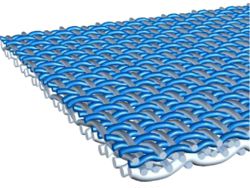LWC machine forming fabric MD ridging problem, a case study
May 7, 2019
Fabrics need to possess uniform rigid dimensional stability in order to lay flat and maintain open area for good drainage properties. If there are any distortions in the fabric, especially bottom side fabrics, basis weight profiles will suffer.
On multiple occasions, Valmet personnel observed a problem called "ridging" of the forming fabric on LWC machines. A ridge would occur over a small cross direction, about 1" wide, that was present all the way around the fabric.
At the ridge, the basis weight would be light, because the stock slurry would roll off the ridge into nearby lanes on a flat fourdrinier machine. It could easily be seen on the dry end of the machine, such as before the dry end calender or at the rereeler unwind.

All wire return rolls were checked in the ridge area to see if there was any debris or defect in the roll covers. Nothing was found. However, the roll over the pulper, the spreader roll, was not inspected due to its location. On one machine, however, this roll had to be removed with a crane to check the cover...
After close inspection, the problem was found to be a small spec of rust that was embedded in the spreader roll’s rubber cover. The size of the rust was very small, only about 1/16". After removing the rust particle from the cover, no more problems were seen with fabric ridging.
One mechanism for the fabric wear due to the spreader roll rust particle is related to the relative speed difference between the spreader roll cover rust particle and the forming fabric. As the particle sticks out, its tip speed is greater than the spreader roll cover and fabric speed. This speed difference, along with the high rpm’s of the smaller spreader roll, caused a buzz saw effect that caused enough damage to large filament wear side strands that they could no longer maintain the dimensional stability of the fabric and created the ridge.
Amazing what such a small piece of debris can cost if it's in the wrong location! Hopefully this problem will never happen on your machine but if it does, now you know where to look for a possible cause.
For more information on fabric care and handling, contact your Valmet representative.